Mannwa is the first CLM region that I really became attached to. That attachment started with the difficulties the region presented.
It is, first of all, beautiful but challenging terrain. Haitians say, “Dèyè mòn gen mòn.” That means, “Beyond mountains there are mountains.” It’s a useful proverb, with numerous meanings. But in Mannwa the proverb is very literally true. It’s a ridge that extends northwest to southeast in north-central Boukankare County, rising up in the west from a mountain stream that separates it from Tit Montay, the county’s isolated western section, and reaching to the east, where it merges with the Balandri ridge that defines much of the border between Boukankare and Tomond, to the north. These two ridges mostly enclose a more-or-less triangular valley. But the valley is not shaped like a cup or a lens or a lemon wedge or like anything regular at all. It’s crisscrossed by a series of lower, but also steep ridges that likewise belong, broadly speaking, to Mannwa. So hiking around Mannwa means constant climbing and descending. It’s rough work.
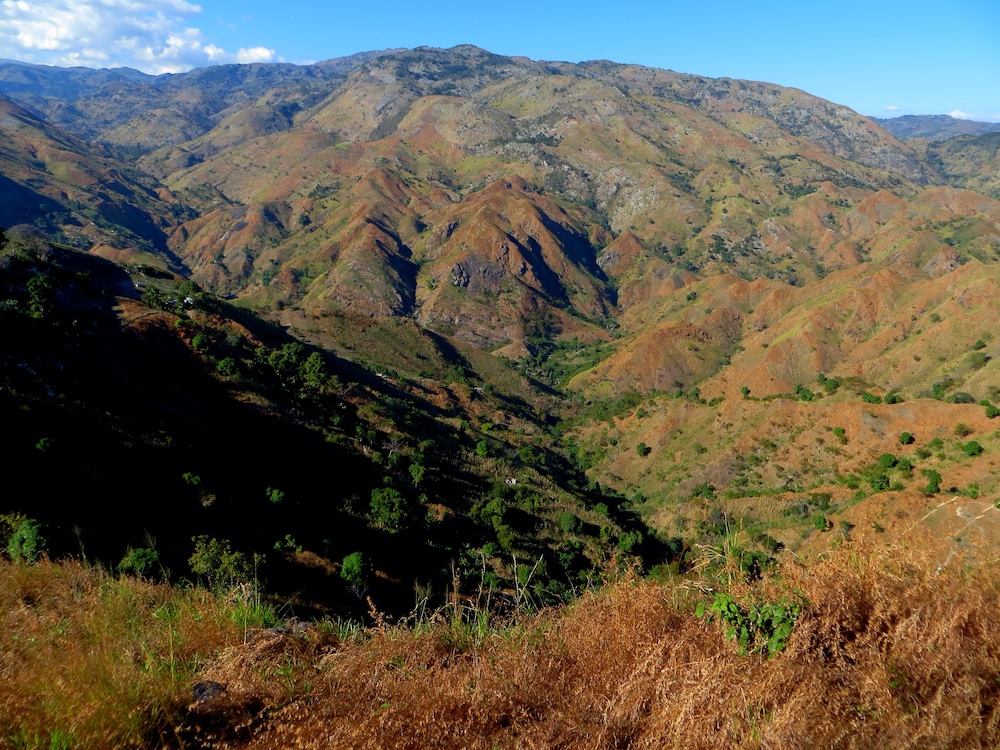
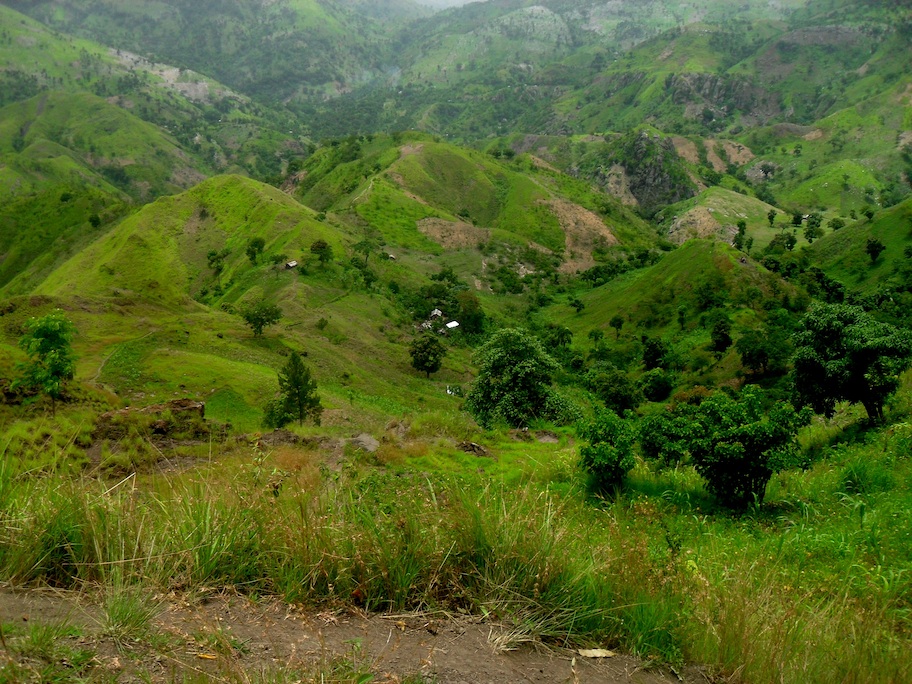
But that wasn’t the real challenge that attached me to Mannwa. I quickly came to enjoy the hiking. I have to admit that I was very hard pressed any time I had to follow Martinière, our case manager there, along his whole route, because it meant walking farther than I can easily walk in a day and, therefore, walking too quickly as well. He would start his Wednesdays at our satellite base well to the west at Zaboka, in Tit Montay, and then had to visit eleven homes, scattered widely throughout the area. But any chance I had to hike through the region, visiting with only a few of the members, was always a pleasure.
So the primary challenge there was never the geography. It was selecting CLM members. Mannwa was one of the first places where I did final selection without help from other members of our program’s leadership – normally we go out in twos or threes to sweep through a neighborhood as quickly as we can – and when I finished selecting families who seemed qualified for the program, about half refused to join.
It is not that unusual for a family to decline our invitation to join CLM. There are always a few. Generally, they have heard rumors about terrible, crazy sounding things that will happen to them if they join. Sometimes, after families have been in the program for a while, they will tell us the rumors that they heard. One doesn’t know whether to laugh or to scream. A young woman from Mannwa once told me that she heard we would make her dance naked. Her husband said that he was told we’d kill him. A woman from Tit Montay once told a gathering that she had heard that we were going to take all the men to Port au Prince and replace them with others. She added that her husband wasn’t much to speak of, but that she was used to him and didn’t want to change.
But in Mannwa an unusually high number of families refused the program. I can’t say whether it was connected to the prominent role that I, the only non-Haitian on our staff, played in the process or if it had something to do with the peculiar character of the neighborhood and its residents. Though I try to be aware of the effects my foreignness can have on our work, I case reason to believe that, in this case, Mannwa’s peculiarity was party responsible. It is the first place we worked where we were able to discover only one community leader whom the poor could name as someone they could turn to for occasional help.
We had seven members in the area along and behind the main ridge, but had as many families who declined. We invested some extra time in trying to change their minds. I went door-to-door, asking each of the families to reconsider. I then organized a meeting for leaders in the community, at which one of our case managers and I talked to them about the program and what it could offer.
I was especially anxious about one young woman, Micheline, an 18-year-old mother, who had been abandoned by the father of her child. She and the child were living with an older sister, but our surveys showed that she owned almost nothing of her own and was going hungry much of the time. She was almost as poor as a mother of only one child could be. But her sister was refusing to let her join. I couldn’t convince her. Even after she appeared to agree to enter the program, she got cold feet at the last minute. She didn’t show up for the first week of enterprise training. When we had to replace her, we added Sorène, a very poor woman with multiple small daughters, who managed to join us by leaving the husband who did not want her to participate.
So although our data showed us that the Mannwa area had numerous families qualified for CLM, we were forced to start with just seven in Mannwa itself and four more in Deniza and Gapi, on the southern side of the ridge.
The most memorable moment from those first stages of work in Mannwa was the visit I made to Rose Marthe in her home. She had given birth to a daughter only days before I met her, so she could not get up from the sleeping mat she was resting on while we spoke. Haitian women tend not to go outside of the home for about the first week after giving birth. I sat on the ground in front of the house as I spoke to Rose Marthe – she had no furniture – and she answered my questions from the mat inside her small shack, where she lay.
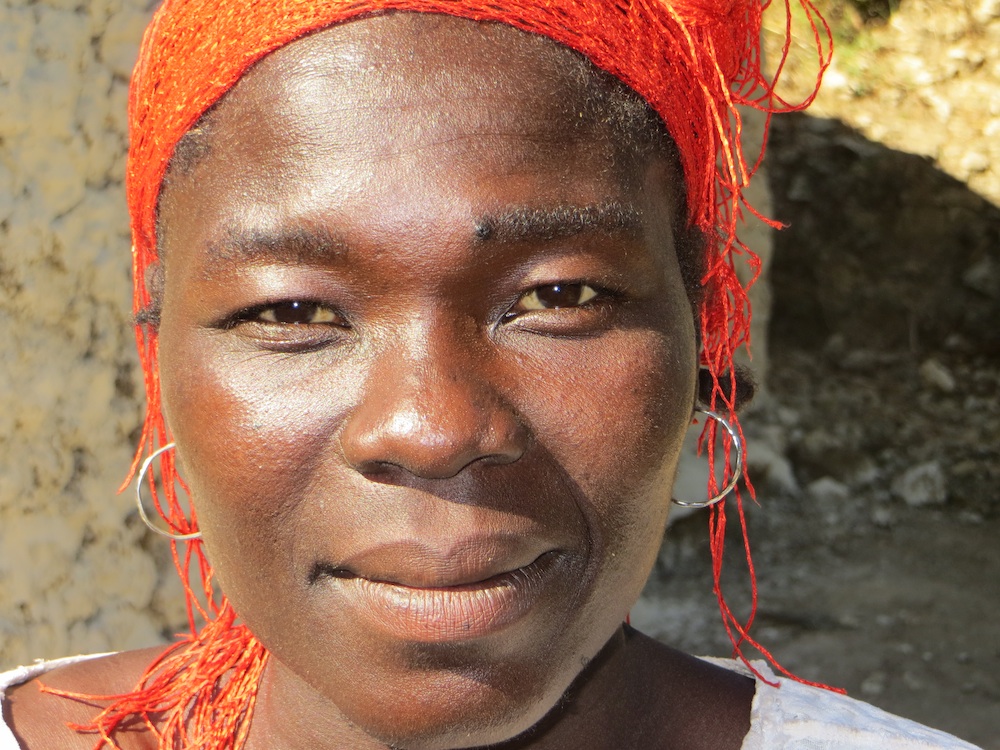
When she looks back on the days when she joined CLM, Rose Marthe speaks in striking terms. “CLM has been very good for me. I was hungry. You could almost say I was naked. Now I eat well, and my kids eat well. They go to school. I have my animals and my commerce. Things are good.” The day I went to see her, six months after graduation, she was unhappy because she couldn’t feed me. It wasn’t that she didn’t have food in the house. She knows, however, that I am a vegetarian and she and her daughter had already prepared their meal with goat meat. It wasn’t a holiday. That’s just how she eats now.
Her life had always been difficult. She was born in Regalis, a market town in southwestern Hinche. When she was a young girl, her parents sent her to live with an aunt because they couldn’t afford to keep her fed. She spent two years with the aunt, travelling between Gonaïves and Okap, helping her aunt manage her business.
She left the aunt when she had had enough of her abuse, and she returned to Regalis. “She beat me too much.” But she didn’t stay long. She went as a teenager to Pétion-Ville, and found a job as a housekeeper, where she spent eight years working in the same woman’s house. She was finally forced to leave when she became pregnant with the woman’s brother’s child. “He came to the house all the time, and started to like me. But when I got pregnant, I had to leave.”
She went back to Regalis and started to raise her child. She couldn’t do it alone, so she hooked up with a man. The boy was about six years old when she got pregnant again. Her second child’s father abandoned her before the next boy was born, but by that time she had gotten together with Sepavre.
His real name is Julius Vil, but you won’t find him in Mannwa by asking for Julius. There’s a lot to be said about nicknames in Haiti, especially in rural Haiti. “//Se pa vre//” means, “It’s not true.” I have no idea how that becomes someone’s name. But that’s what everyone who knows Julius calls him.
Sepavre was already married at the time, but Rose Marthe was willing to be a second wife because Sepavre would help her raise the child she was pregnant with when they met. Her first child died during that second pregnancy, and Sepavre buried the boy and organized the funeral.
So Rose Marthe and Sepavre started their life together. She lived in a small straw shack, with her infant boy and a little girl, his daughter from a previous relationship. The shack was just a few hundred yards uphill from his other wife’s house. Sepavre would split time between them.
He was very hard working, but most of the assets he worked with belonged to his other wife. Rose Marthe had very little she could give him to work with, so he had very little he could bring her in return. They got on well together, but as they had more children, their poverty only deepened. She would work as a day laborer in wealthier neighbors’ fields to earn a little cash. The only way she and Sepavre could plant their own fields was to borrow the beans, repaying them with interest when the harvest came in. The interest rate would vary seasonally, but could range as high as 100%.
That’s when CLM came to Mannwa. Rose Marthe now credits CLM for very much improving her life, but her path through the program was not easy. With a newborn in her hands as we got started, she had no way to begin with a small commerce. So the two assets she chose were goats and a pig.
Goat rearing went well for her from the start. We gave her two goats, and she bought herself a third with proceeds from a savings club that she joined with fellow CLM members. Wòch Djèp, the western corner of Mannwa where she lives, is good country to raise goats in. There is plenty of forage, so they’re likely to do well as long as you can keep them out of your neighbors’ fields, which is something that Rose Marthe and Sepavre were very careful to do. Six months after graduation, Rose Marthe had eight goats, even though she had sold several in order to make other investments.
Pig rearing was another story. Rose Marthe joined CLM just as an epidemic of Teschen disease, an incurable and usually fatal pig disease, was sweeping through Haiti’s Central Plateau. Her pig caught the disease, and died.
She was determined, though. She raised what she could from sale of the meat, added some of the money she saved from her weekly food stipend, and bought a second pig.
This second one was just a piglet. It would have taken a lot of time and energy for it to generate a return. But pig rearing, though risky, can return a very high profit. So she and her case manager decided to give it another try. When the second pig died, Rose Marthe wept.
So she turned her focus towards the goats, but also made an important change in the way she farmed. She bought the beans that she needed for planting with cash from her savings. That meant the whole harvest was hers. She and her children would have plenty to eat, she would keep some to plant, and she’d still have something to sell. She added some of her savings to the proceeds from her first cash-based harvest, and was able to begin a small commerce. She’d buy produce – beans or corn, usually – in a either Zaboka or Regalis, remote mountain markets where prices are low, and then she and Sepavre would carry sacks on their heads to other less rural markets where they could be sold at a profit. It might mean hiking four or five hours with their load, but the money was good.
She finally was able to earn enough that she was able to use some of her profits, together with proceeds for the sale of a couple of goats, to buy a mule. It cost 11,500 gourds, or about $275, but it can carry much more than she can, so it has enabled her business to grow even more. In addition, she was able to set aside enough beans that she now lends them to neighbors at a profit.
So economically, even though she has struggled, Rose Marthe has succeeded wonderfully. But she almost lost everything she had midway through her experience in the program when she came down with cholera.
Under the best of circumstances, cholera is dangerous, but when you live in a remote area such as Wòch Djèp, the danger is much greater. Rose Marthe shouldn’t have been vulnerable to cholera. She knew better. Her case manager taught her about cholera every week. She learned about the importance of washing her hands. CLM gave her a water filter. And we helped her build a latrine in her yard. But she was probably careless while snacking in a market. None of the other members of her household caught the disease, but another CLM member who lives nearby and walks to market with her did.
Rose Marthe tells the story: “I started to feel sick and to vomit early in the day. I had diarrhea, too.” Her neighbor, Edres, is a Partners in Health extension agent, so he had some medication on hand. “I drank what I could, but things got worse and worse. By the time my husband knew I was sick, I was too far gone to make any decisions.”
Partners in Health has a free cholera center in Boukankare, a two-three hour walk from their home, but Sepavre and their neighbors carried her to a private center in Zaboka, instead. It was no closer, and was expensive, but Sepavre is from Zaboka, and he wanted her to be near family. He would need to stay with the kids, but didn’t want her to be at the clinic by herself.
I happened to be in Zaboka the day after she was brought to the clinic, and even with a day of intravenous fluid in her, she looked bad. But as dangerous as cholera is, it appears to be relatively easy to cure, and Rose Marthe pulled through without lingering effects.
It takes about fifteen or twenty minutes to hike from Rose Marthe’s place east to the closest CLM member, Magalie. About the same distance east of Magalie’s house is a separate, north-running ridge. The area from Magalie’s house to this second ridge is called Lalyann. On the southern side of that ridge, close to where you begin a steep climb up to Mannwa, lives Omène. Chrismène lives at the ridge’s northern tip, just when it begins to descend into a narrow ravine.
When we met Chrismène during the member selection process, she told us that her husband, Elgué Jean Pierre, had abandoned her to seek his fortune in the Dominican Republic. Chrismène was just 23 when she joined CLM, with an oldest daughter who must have been eight or nine. At the time, she had little with which to keep her children even minimally fed: just a small plot of land that she would farm, and two chickens.
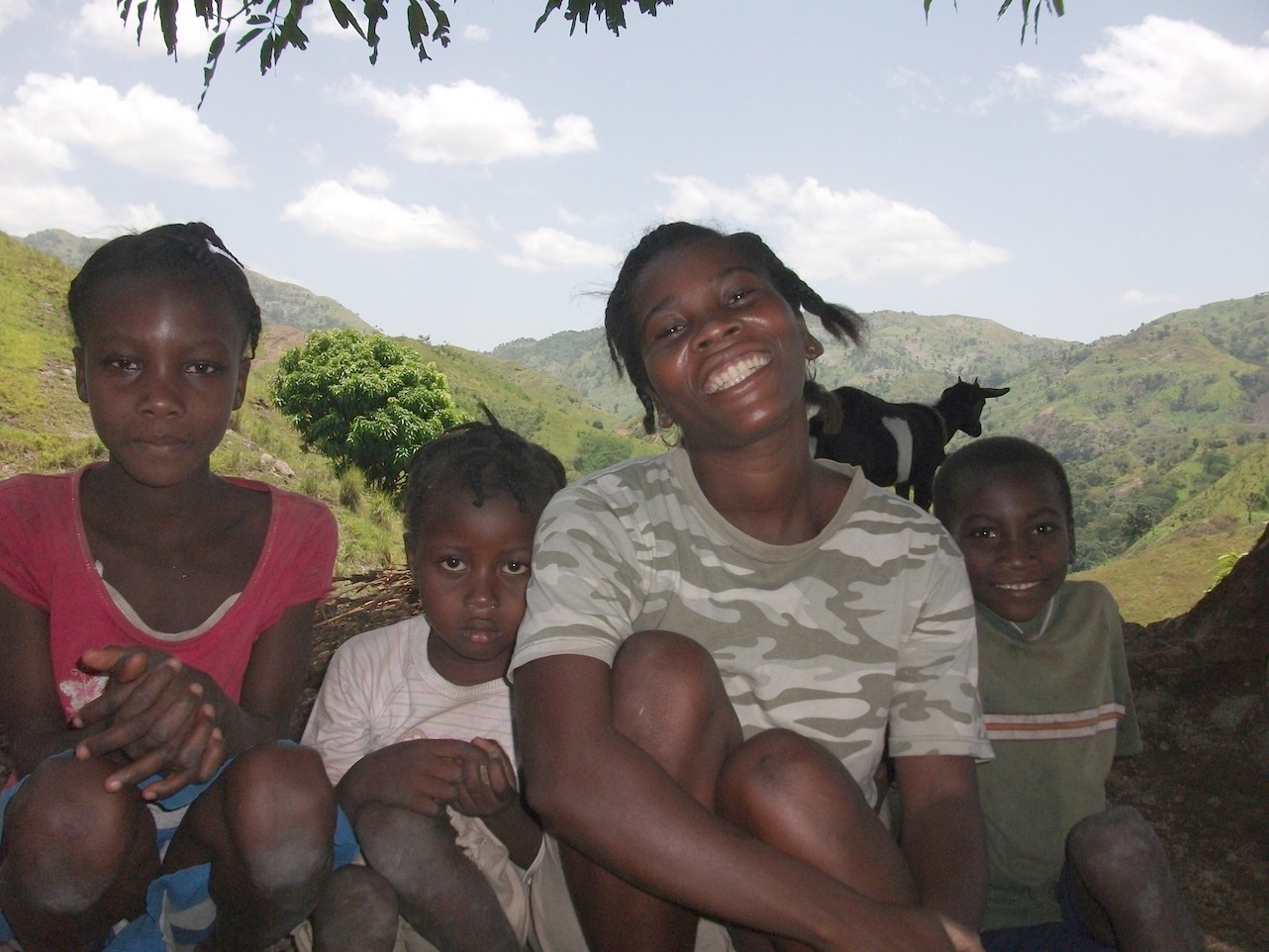
Her original Poverty Scorecard is confusing. The Poverty Scorecard is the longer, more detailed of the two surveys we use as part of the selection process. Together, they collect a range of information that helps us judge a family’s standard of living. Chrismène’s Scorecard reports her, on one hand, as having a partner who would work the land and was responsible for more than half of the household income. It also says, on the other, that he had left her and gone to the Dominican Republic.
Her other form, the Food Security Survey was much clearer. She scored as badly as one could have. She and her children were regularly going hungry, depending on her husband’s family for an occasional handout to keep themselves going.
But from her first entry into the program, Chrismène flourished. She took excellent care of her animals, and they multiplied. She invested cash that she saved from her stipend in her farming, and was rewarded with strong harvests. And she worked quickly and with discipline to take advantage of the materials the program made available for her to repair her home and build a latrine.
We were at first surprised to see how quickly she was able to get her house built. Home repair is one of the areas in which we tend to see a big difference between the women who live with supportive partners and those who are single. This is because there is a lot we insist that members do towards building their own home, things more easily done with a husband’s help. Though we provide roofing material and nails, along with cement for latrines, members must provide all the lumber, sand, rocks, and mud that construction requires.
Chrismène is a small woman, and her children are still too young to help her. When the program started, she didn’t yet own a pack animal. Though she could help get the building materials to her home, she would need someone to do the heavier lifting. Getting building materials from Kafou Jòj, the nearest approach a loaded truck could make, up the slope to Mannwa, and then back down the other side to Lalyann would be no joke. And with Elgué in the Dominican Republic, we were not sure how she’d manage.
It turned out not to be a problem. Plentiful help came from what at first seemed a surprising source. Omène is a slightly older woman, and is married to Elga Jean Pierre, who had been introduced to us by Omène and Chrismène as Elgué’s twin brother. We were continually impressed by his willingness to come to his sister-in-law’s aide. He helped her collect the lumber she’d need to build her house, to get her materials to Lalyann from Kafou Jòj, to work in her fields, and to manage her animals.
It also turned out to be less surprising than we had thought. One day, Chrismène’s case manager, Martinière, was passing through the neighborhood, and went by a meeting that Edres was holding for all the mothers in the area. Both Chrismène and Omène were there, and one of their neighbors, looking at how well they seemed to be doing since entering the program, remarked that Elga’s wives were looking good. Martinière looked at the two women and they looked at him. The three of them could only laugh.
Elgué never went to the Dominican Republic. He is, in fact, Chrismène’s son. Her husband is actually Elga, the same man who is husband to Omène. The women explained that they had been afraid to tell us the truth, worried that we would accept only one of the two wives into the program. So they conspired to deceive us – not that they needed to – and they succeeded for a while.
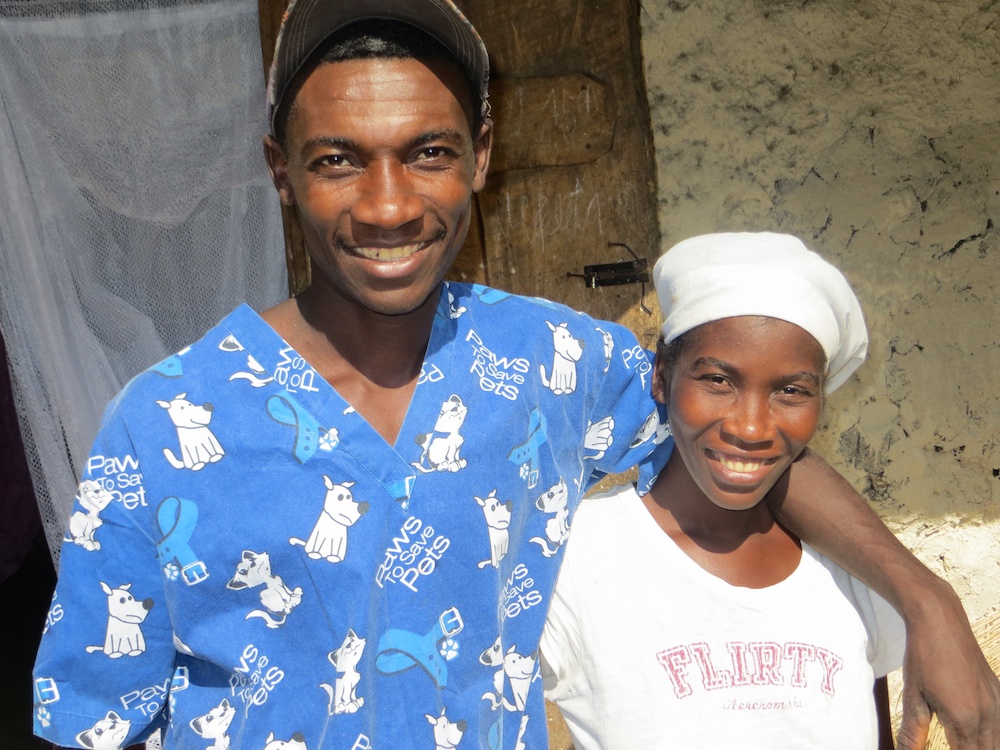
Elga and Chrismène
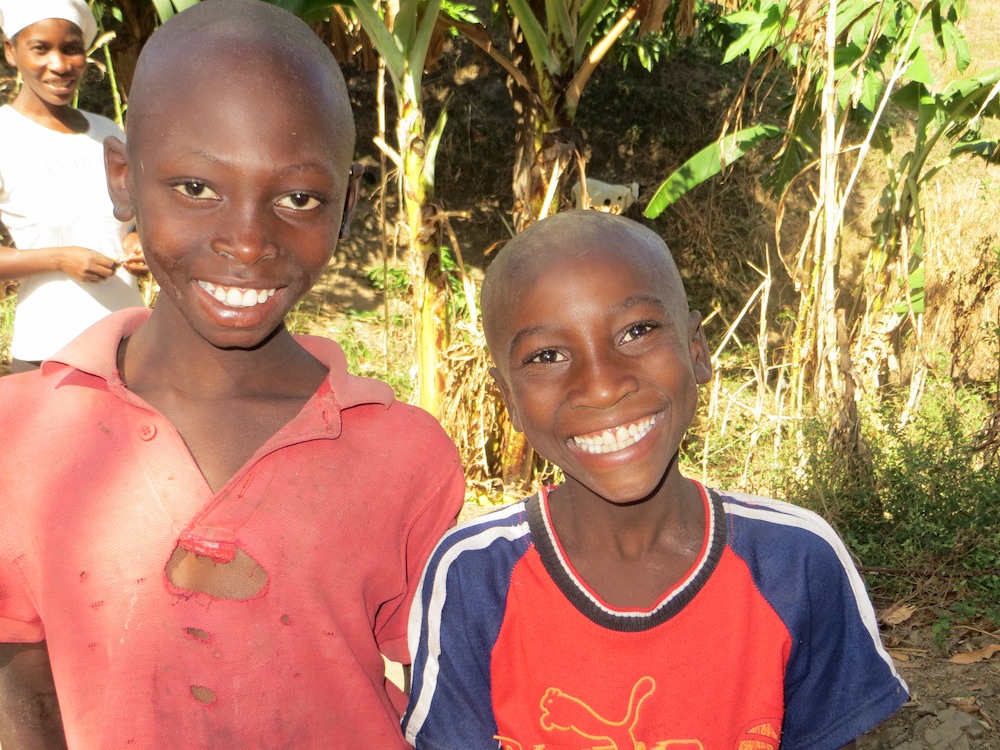
The real Elgué, Chrismène’s son, on the right. On the left is Benole, Omène’s son and Elgué’s brother.
In French, a “matelot” is a sailor. The word appears to be connected to the word for mattress. Two sailors would share one hammock by sleeping at different times. The shared sleeping arrangement turned into a name for the class of sailors themselves.
The Creole word “matlòt” is most likely derived from a feminine version of the French, but its meaning is somewhat different. Matlòt are woman like Chrismène and Omène, who share the same husband.
It’s not an unusual arrangement in rural Haiti. We regularly come across situations in which men have two or three wives. They may be married legally to one of them. With or without a legal marriage, community members may recognize one of the women as the madanm marye, or the real wife. In Elga’s case, Omène is the madanm marye. But the men are not necessarily legally married to any of them. Sepavre is married neither to Rose Marthe, nor to the other woman who lives nearby. In fact, he left the other woman a few months after Rose Marthe graduated, quickly taking up with a new second wife. Sometimes the men have reasonably stable relations with all.
And it is, perhaps, not surprising that such families are very well represented in CLM. Men who establish two or more households are bound to have more trouble supporting their wives and kids. Both their harvests and whatever cash they might earn have to be spread around more thinly. Omène and Chrismène are two of the more fortunate examples of a phenomenon we see all the time: Polygamy is a rich source of extreme poverty.
Chrismène also had more than Elga to aide her. She also received help from her older sister, Joceline, who is also a CLM member, but who lives with her husband in another part of Boucan Carré. The sister returned to Lalyann while Chrismène was building the house to help collect the stones and the mud that construction would require.
Chrismène wasn’t born in Lalyann, but in Pidem, a small, hilly region of western Boucan Carré, close to the river that cuts the commune almost in half. Her parents died when she was a little girl. By then, the family’s poverty had forced them to send Joceline away to live as a domestic servant in Elga’s parents’ home. When the parents died, Joceline asked Elga’s family to take her little sister in as well, and they agreed to do so. Chrismène moved into their home when she was about seven or eight years old.
Elga started flirting with Chrismène just a few years later. “I wasn’t quite ten,” she explains. Within a few years, she was pregnant with their first child. She could only have been thirteen or fourteen. That first child died, but they had their second only about a year later. Not long after that, Elga started dating Omène, whom he eventually married. He and Omène have five children together, and he has three surviving children with Chrismène. Though Elga and the two women are clear as to who his legal wife is, he says he is unswerving in his commitment to Chrismène. “I could never abandon her, “ he says, “I’ve made her suffer too much.”
Both women transformed their lives during eighteen months of the program. When they were evaluated for graduation in late June 2012, both women scored perfect 10s, meeting or exceeding all graduation criteria. They could have graduated with scores as low as seven. Omène, the less wealthy of the two, had succeeded in accumulating assets worth over 18,000 gourds – or about $440. That’s more than three times the assets that are minimally required for graduation. Chrismène had over 21,000 gourds’ worth – more than $520 – mostly in livestock. She had turned the two goats that we has given her into seven; she had bought a horse that had already given her a colt; she had a small pig and five chickens; and was continually earning new income by farming the small plot that was hers. A few months after graduating, she sold three goats, a live pig, some pork meat, and part of a crop of beans to buy a cow.
Her success was the source of some jealousy. Omène was not able to buy a horse until shortly after she graduated, and she seemed to resent the fact that Chrismène was ahead of her. But she didn’t let her resentment amount to anything. In general, she remains the same woman who joined in the conspiracy about her husband that they thought would be necessary for both her and her matlòt, Chrismène, to be accepted into CLM.
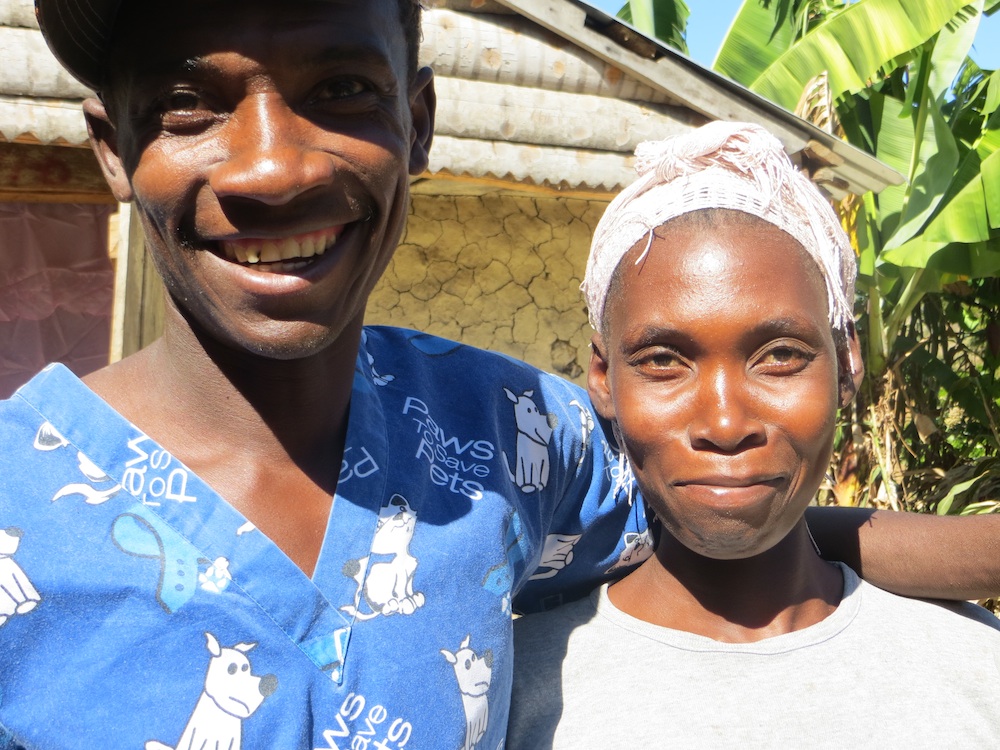
Elga and Omène
Both Omène and Chrismène are facing hardship six months after graduating from CLM. Chrismène woke up one morning to find that her horse had died. Fortunately its colt is old enough to survive, but it is a very big loss. In Omène’s case, the mother horse is fine, but its first colt was stillborn.
But both are confident that they can overcome their difficulties. And they have reason to feel confident. They are resilient now, capable of managing the steps backwards that they’ll face now and again. Chrismène has her cow, her colt, and three large female goats. Two of the three have kids, and the third is pregnant. Though food is not right now as plentiful in her home as has been recently – she’s reached the last weeks before her large millet harvest – she still has plenty of yams and pigeon peas to ensure that she and her children manage well enough. They aren’t hungry. Omène has eight goats and her horse, and a small field of plantain trees right next to her house. They both have chickens that they use for eggs, meat, or can sell if they need a little cash.
Most importantly, all three women – Chrismène, Omène, and Rose Marthe – are truly graduates in the sense that they have lifted themselves out of extreme poverty and are now leading different, sustainable, and still-improving lives. Talking with them, one senses their optimism. One feels that they each have plans and the capacity to carry their plans out.